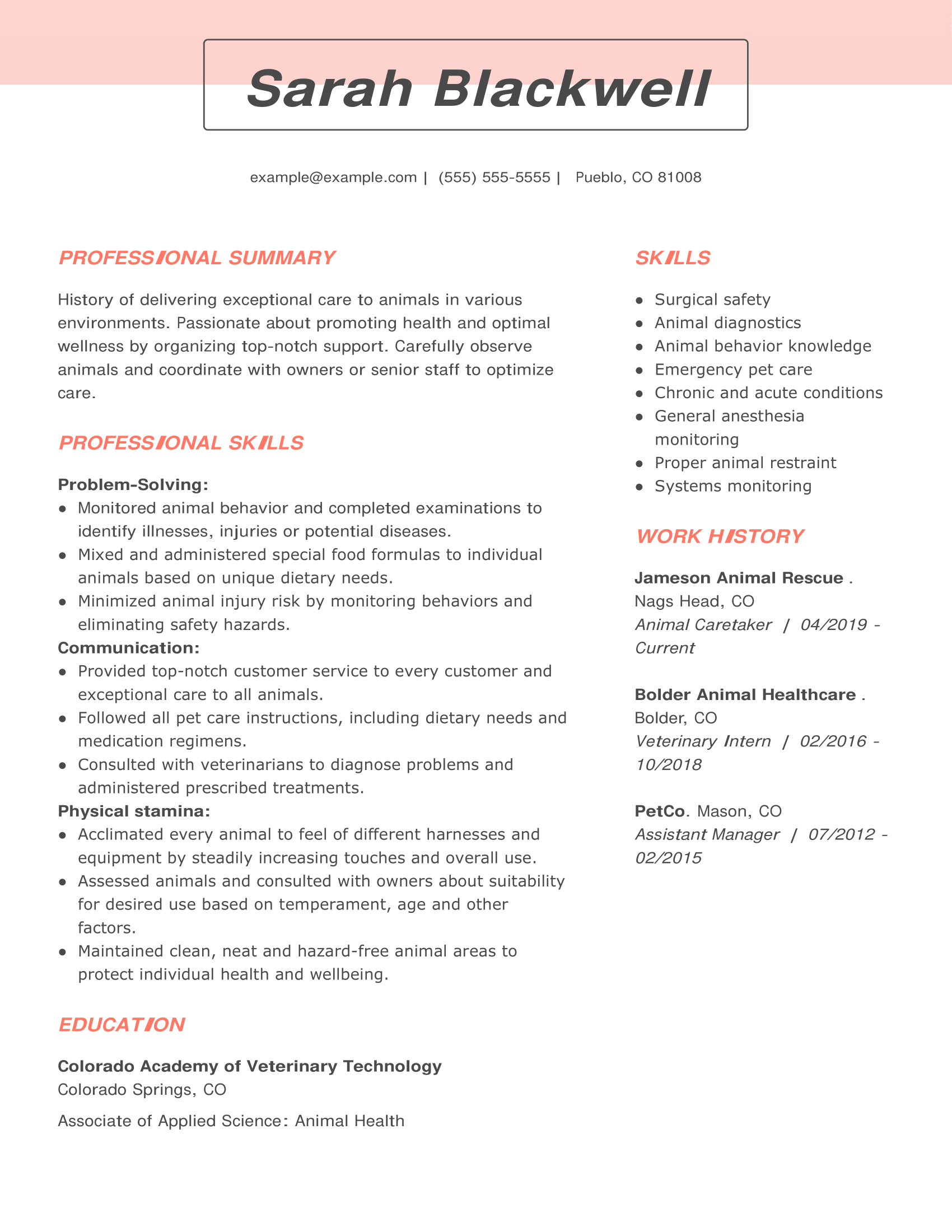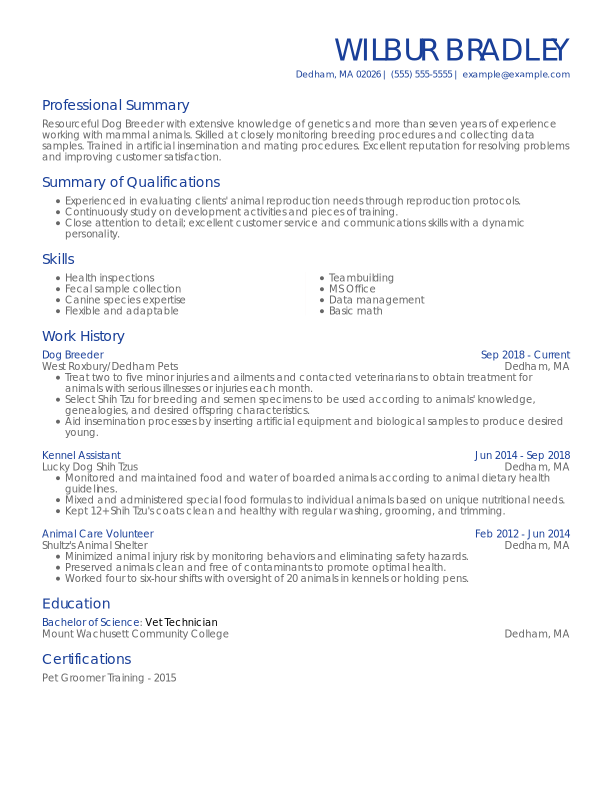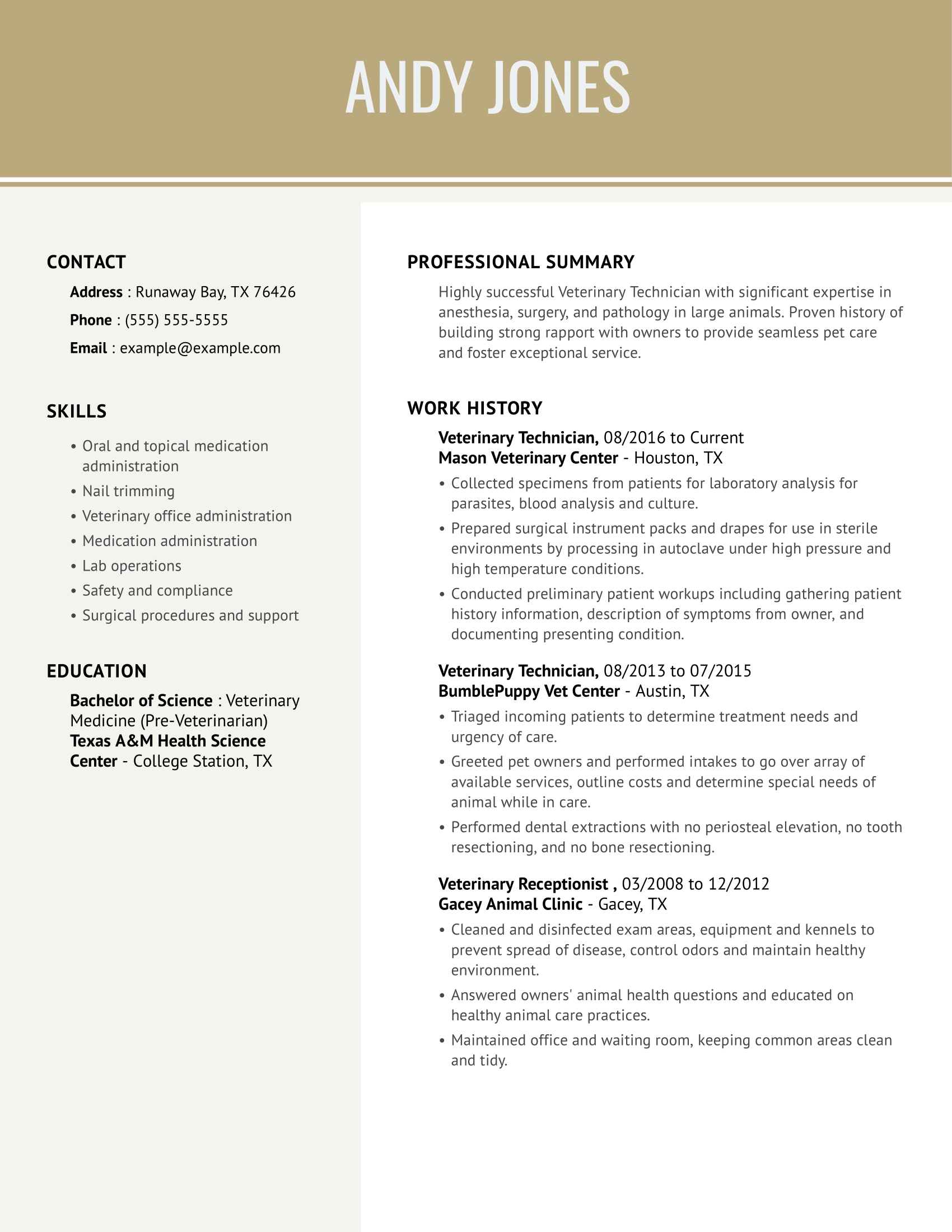Why this resume works
- Quantifies accomplishments: The resume quantifies accomplishments effectively, citing improvements like a 15% recovery rate increase and performing over 200 complex surgeries, underscoring the candidate’s tangible impact.
- Showcases career progression: This resume showcases the job seeker’s career progression from veterinary technician to veterinarian roles, reflecting increased responsibility and leadership in team management and advanced surgical procedures.
- Highlights industry-specific skills: Industry-specific healthcare skills are highlighted through achievements like reducing complications by 20% and conducting over 100 emergency surgeries.
More Veterinarian Resume Examples
Review our veterinarian resume examples to see how to emphasize your medical expertise, animal care experience, and client communication skills. These veterinary resume samples provide a strong foundation for creating a resume that highlights your qualifications and dedication.
Entry-Level Veterinarian
Why this resume works
- Features a strong education section: The education section stands out by clearly presenting relevant and essential degrees for early career professionals.
- Effective use of keywords: Keywords like “animal surgery,” “emergency care,” and “clinical protocols” are strategically used, enhancing the resume’s chances of passing through applicant tracking systems.
- Shows digital literacy: Mentions workflow optimization and inventory management, reflecting computer skills and proficiency with modern technical tools in veterinary practices.
Mid-Level Veterinarian
Why this resume works
- Includes a mix of soft and hard skills: Responsibilities like team management and client communication alongside technical roles such as surgeries and diagnostics highlight a well-rounded mix of soft skills and hard skills.
- Demonstrates language abilities: Proficiency in English, Spanish, and basic French showcases the job seeker’s language skills and capability to engage in cross-cultural communication, vital for international project work.
- Displays technical expertise: Conducting over 150 successful surgeries and implementing advanced diagnostic tools emphasizes technical skills and expertise essential for a veterinary role.
Experienced Veterinarian
Why this resume works
- Lists relevant certifications: The resume lists certifications like Certified Veterinary Acupuncturist and Fear Free Certified Professional, underscoring expertise and dedication to continuous professional development.
- Showcases impressive accomplishments: Significant achievements such as conducting over 200 successful surgeries and improving treatment outcomes by 25% highlight the candidate’s senior-level impact in veterinary care.
- Sections are well-organized: Clear headers and bullet points for each role make the resume easy to scan, ensuring key responsibilities and achievements stand out immediately.
Veterinarian Resume Template (Text Version)
Min Nguyen
Seattle, WA 98103
(555)555-5555
Min.Nguyen@example.com
Professional Summary
Dedicated veterinarian with 5 years of experience in surgery, emergency care, and diagnostics. Proven track record in improving recovery rates and reducing complications. Strong leader skilled in team management and client communication.
Work History
Veterinarian
Hillcrest Animal Hospital – Seattle, WA
March 2024 – March 2025
- Improved recovery rate by 15% using new treatment plans
- Conducted over 100 routine and emergency surgeries
- Led a team of 5 veterinary assistants and technicians
Veterinary Surgeon
Cedar Park Pet Clinic – Silverlake, WA
June 2022 – February 2024
- Performed 200+ complex surgical procedures
- Reduced complications by 20% with enhanced pre-op prep
- Trained new surgeons in advanced surgical techniques
Veterinary Technician
Lone Star Veterinary Center – Silverlake, WA
March 2021 – May 2022
- Assisted in 300+ patient exams and diagnostics
- Implemented a new inventory system, saving 10% annually
- Educated pet owners on preventive care and diet
Languages
- English – Beginner (A1)
- Spanish – Beginner (A1)
- French – Intermediate (B1)
Skills
- Surgical Procedures
- Emergency Care
- Patient Diagnostics
- Treatment Planning
- Team Leadership
- Client Communication
- Preventive Medicine
- Animal Nutrition
Certifications
- Certified Veterinary Surgeon – American College of Veterinary Surgeons
- Animal CPR Certification – Red Cross
Education
Doctor of Veterinary Medicine Veterinary Medicine
Texas A&M University College Station, Texas
May 2021
Bachelor of Science Biology
The University of Texas at Austin Austin, Texas
May 2017
Related Resume Guides
Advice for Writing Your Veterinarian Resume
Discover how to write a resume for a veterinarian position and learn how to highlight your expertise in animal care, medical knowledge, and compassionate practice. Explore our tips designed specifically for veterinarians to help you stand out in this rewarding field.
Write a strong professional summary
A professional summary is a concise paragraph at the top of your resume that emphasizes your main skills, experiences, and accomplishments. For an experienced veterinarian, it highlights your proficiency in animal care, client relations, and medical procedures, making a powerful first impression by swiftly showing why you are ideal for the job.
If you have limited experience as a veterinarian, consider using a resume objective instead. This section outlines your career aspirations and how they match the position you’re seeking. Use dynamic language to highlight what you offer, like “passionate about animal welfare” or “committed to delivering excellent patient care.”
For an impactful professional summary or objective, prominently feature your most relevant skills and achievements. Mention specific expertise areas such as surgery, diagnostics, or emergency care. Arrange this section clearly so employers can easily understand how your background meets their requirements.
Veterinarian resume summary examples
Entry-level
Recent veterinary school graduate with a Doctor of Veterinary Medicine (DVM) degree and licensed to practice in the state of New York. Proficient in performing basic surgeries, conducting diagnostic tests, and providing routine care for small animals. Passionate about animal welfare and dedicated to delivering compassionate and high-quality veterinary care.
Mid-career
Experienced veterinarian with over 7 years of hands-on experience in small animal practice. Skilled in advanced surgical procedures, diagnostic imaging, and client communication. Certified in Veterinary Acupuncture (CVA) and known for effectively managing complex medical cases while maintaining strong client relationships. Committed to continuous learning and improving patient outcomes.
Experienced
Veterinarian with over 15 years of comprehensive experience specializing in emergency medicine and critical care. Proven leadership skills as Chief Veterinarian at a leading animal hospital, overseeing a team of veterinarians and support staff. Board-certified by the American College of Veterinary Internal Medicine (ACVIM). Successfully implemented protocols that reduced treatment times by 20% while improving patient recovery rates. Passionate about mentoring young veterinarians and advancing veterinary medicine through research.
Veterinarian resume objective examples
Recent graduate
Recent graduate with a Doctor of Veterinary Medicine (DVM) degree, eager to begin a career in veterinary medicine. Enthusiastic about applying academic knowledge and practical skills to provide high-quality care for animals while contributing positively to the growth and success of a dedicated veterinary team.
Career changer
Passionate professional transitioning into the field of veterinary medicine, bringing a strong background in biology and animal science coupled with hands-on experience through volunteer work at local shelters. Committed to delivering compassionate care, supporting animal welfare, and continuously learning in a dynamic clinical environment.
Specialized training
Recent DVM graduate with special interest and training in exotic animal care seeking an entry-level veterinarian position at a diverse and progressive practice. Dedicated to utilizing specialized knowledge to provide exceptional medical treatment, preventive care, and support for common pets and exotic species.
Use our Resume Builder to create your veterinarian resume quickly and easily. It helps you highlight your skills and experience in a professional format.
Include relevant certifications and training
When you’re a veterinarian, it’s very important to showcase your certifications and training. This proves you have the right skills and knowledge for the job. By having a dedicated certifications section on your resume, you can make sure these important credentials stand out. This is especially useful in technical fields where specific qualifications are required.
Include this section along with your education details to give a full picture of your expertise. For example, you might list certifications like:
- Certified Veterinary Acupuncturist (CVA)
- Board Certification by the American College of Veterinary Internal Medicine (ACVIM)
- Fear Free Certified Professional
- USDA Accredited Veterinarian
- CPR and First Aid Certification
Make sure to list each certification clearly, mentioning the issuing organization and the date you received it. Highlighting these achievements can help employers see that you’re well-qualified and dedicated to continuing education in your field. See the example below to get started.
Example of a certifications section
Doctor of Veterinary Medicine (DVM)
Issued by: American Veterinary Medical Association (AVMA)
Issued 2018
Certified Veterinary Acupuncturist (CVA)
Issued by: International Veterinary Acupuncture Society (IVAS)
Expires 2025
Board Certified Specialist in Canine and Feline Practice
Issued by: American Board of Veterinary Practitioners (ABVP)
Issued 2020
Fear Free Certified Professional
Issued by: Fear Free, LLC
Expires 2023
Certified Aquatic Veterinarian
Issued by: World Aquatic Veterinary Medical Association (WAVMA)
Issued 2021
We recommend using one of our professional resume templates to easily create a resume that effectively presents your skills and qualifications.
Showcase your work experience
Effectively presenting your work experience on a veterinarian resume is vital for illustrating the practical skills and knowledge you’ve accumulated. Listing your job experiences in reverse chronological order, starting with the most recent one, allows hiring managers to quickly grasp your career development and the relevance of your previous roles.
When detailing your work experience, mention the job title, employer name, location, and employment dates. Use concise, action-driven bullet points to outline your responsibilities and achievements. For instance:
- Performed routine surgeries like spaying/neutering and dental cleanings.
- Conducted thorough exams and administered vaccinations.
- Diagnosed illnesses using lab tests and imaging technology.
Whenever possible, emphasize measurable outcomes to better demonstrate your contributions. Examples include:
- Enhanced client satisfaction scores by 20% through effective communication and follow-up care.
- Successfully treated over 500 animals each year.
Key responsibilities for veterinarians typically involve diagnosing animal health issues, performing surgeries, advising pet owners on proper care, handling emergencies, and maintaining medical records. Clearly listing these relevant skills in an organized format showcases your expertise and readiness for the role.
5 veterinarian work history bullet points
- Diagnosed and treated over 1,500 animal patients annually, improving recovery rates by 20%.
- Performed complex surgical procedures with a 95% success rate, enhancing overall clinic reputation.
- Implemented a new preventive care program, increasing client compliance by 40% and reducing emergency visits.
- Trained and supervised a team of 8 veterinary technicians, boosting department efficiency by 25%.
- Developed and launched a community outreach initiative that increased new patient intake by 30%.
Incorporate keywords in your resume from the job listing to increase your chances of passing ATS and standing out to hiring managers.
Match your resume with the job description
Customizing your resume to match the job description is crucial for standing out in the competitive field of veterinary medicine. By creating a targeted resume, you demonstrate to employers that you possess the specific skills and experience they seek.
This approach can significantly improve your chances of being noticed by both hiring managers and Applicant Tracking Systems (ATS), which scan resumes for relevant keywords.
Begin by carefully reading the job posting and highlighting key terms such as “animal diagnostics,” “surgical procedures,” or “client communication.” Integrate these terms into your resume to showcase that you meet the required qualifications.
For instance, if a job posting mentions “performing diagnostic tests,” you could rephrase this into a resume bullet point like: “Conducted comprehensive diagnostic tests including X-rays and blood work to accurately diagnose animal health issues.”
Clearly organize your sections with headers like Skills, Experience, and Education. Under each section, list achievements that directly relate to the job description. Highlighting specific accomplishments not only adheres to ATS-friendly resume criteria but also demonstrates real-world applications of your expertise as a veterinarian.
Make sure your resume gets noticed! Our ATS Resume Checker helps you find and fix mistakes and add important keywords to stand out to employers.
Salary Insights for Veterinarians
Salaries can vary based on your location and job title. Analyzing industry pay trends can help you compare earnings and make informed career decisions. Explore the details below.
Top 10 highest-paying states for veterinarians
Our salary information comes from the U.S. Bureau of Labor Statistics’ Occupational Employment and Wage Statistics survey. This official government data provides the most comprehensive and reliable salary information for veterinarians across all 50 states and the District of Columbia. The figures represent the most recent data available as of May 2023.
The national average salary for veterinarian is $116,819.
| State | Average Salary |
|---|---|
| Massachusetts | $162,030 |
| California | $158,610 |
| Hawaii | $157,770 |
| District of Columbia | $156,570 |
| Arizona | $153,480 |
| New Jersey | $153,630 |
| New York | $151,100 |
| Wisconsin | $150,910 |
| Rhode Island | $148,920 |
| Florida | $143,950 |
FAQ
Do I need to include a cover letter with my veterinarian resume?
Including a well-written cover letter with your veterinarian resume can significantly strengthen your application. It allows you to convey your enthusiasm for veterinary medicine, explain your interest in a particular clinic or practice, and emphasize the qualifications that make you a strong candidate.
For example, if the practice treats exotic animals and you have specialized training in that area, the cover letter is an ideal place to highlight this expertise. It’s also an opportunity to demonstrate your commitment to animal care and share any unique skills or certifications that may not be fully reflected in your resume.
To get started, explore cover letter examples for inspiration or create your own using our Cover Letter Generator. A tailored cover letter helps employers better understand your background, professional values, and potential fit within their team.
How long should a veterinarian’s resume be?
As a veterinarian, aim for a resume length of one to two pages. If you’re just starting out or have fewer roles to highlight, a single page is sufficient.
For those with more experience, a two-page resume lets you detail your clinical experience, specializations, and significant achievements without overwhelming the reader.
Concentrate on recent and relevant positions, key surgeries or treatments you’ve performed, and any continuing education or certifications in veterinary medicine to maintain clarity while showcasing your expertise effectively.
How do you write a veterinarian resume with no experience?
When creating a resume with no experience for a veterinarian role, emphasize your education, skills, and relevant training that prove your readiness.
- Start with your education: Highlight your veterinary degree by listing the institution’s name, graduation date, and any honors or achievements to demonstrate your foundational knowledge and dedication to the field.
- Highlight clinical training: Detail internships, externships, or clinical rotations. Mention where you worked, the species you handled (small animals, large animals, exotics), and key duties such as exams or emergency care.
- Showcase relevant skills: Focus on transferable skills like animal handling, diagnostic procedures, lab techniques, client communication, and medical treatments. If applicable, include workshops or certifications.
- Include volunteer work: Note any volunteer experiences at animal shelters, wildlife rescues, or community clinics to show your passion for veterinary care and practical experience working with animals.
Finally, tailor your resume to each job by emphasizing parts of your background that closely match the specific role you’re applying for.
Rate this article
Veterinarian
Additional Resources

Animal Caretaker Resume Examples & Tips
Animal caretakers look after animals in zoos, shelters and other hosting facilities, providing them with fresh food, clean water, a clean environment, adequate physical exercise, grooming, medications, and anything else

Dog Breeder Resume Examples & Tips
Dog breeders produce and train dogs for shows, companionship or pets, with duties ranging from feeding, grooming and bathing dogs to providing medication, assisting in births, studying up on pedigrees,

Veterinary Technician Resume: Examples & Tips
Veterinary technicians assist in providing care to unwell or injured animals, handling routine checkups as well as emergency nursing under a veterinarian’s guidance. Tasks for this job include health checks,

Problem-Solving Skills: Examples for Your Resume
In today's competitive job market, the ability to solve problems efficiently and effectively is a highly sought-after skill that can set you apart from other candidates. By highlighting problem-solving skills on
